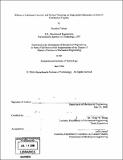| dc.contributor.advisor | Victor W. Wong. | en_US |
| dc.contributor.author | Takata, Rosalind (Rosalind Kazuko), 1978- | en_US |
| dc.contributor.other | Massachusetts Institute of Technology. Dept. of Mechanical Engineering. | en_US |
| dc.date.accessioned | 2007-01-10T16:55:07Z | |
| dc.date.available | 2007-01-10T16:55:07Z | |
| dc.date.copyright | 2006 | en_US |
| dc.date.issued | 2006 | en_US |
| dc.identifier.uri | http://hdl.handle.net/1721.1/35644 | |
| dc.description | Thesis (S.M.)--Massachusetts Institute of Technology, Dept. of Mechanical Engineering, 2006. | en_US |
| dc.description | Includes bibliographical references (p. 117-120). | en_US |
| dc.description.abstract | The piston ring-pack contributes approximately 25% of the mechanical losses in an internal combustion engine. Both lubricant viscosity and surface texturing were investigated in an effort to reduce this ring-pack friction and increase engine efficiency. While both optimizing viscosity and surface texturing are predicted to cause a reduction in ring/liner friction individually, a combined approach may cause an even greater friction reduction while mitigating unwanted side-effects such as oil consumption and wear. Existing MIT models, with some modifications and supplementary programs to allow investigation of the parameters of interest, were used to conduct this research. A ring-pack model based on average flow-factor Reynolds analysis was used for both studies, with a modified form of this program, along with a supplementary deterministic model for surface analysis, used for the study of surface texturing. Although these advanced models are applicable in a wide range of cases, the surface textures studied in this research are very different than a typical cylinder liner surface, and can be represented only approximately by the averaged Reynolds analysis upon which the ring simulation is based. | en_US |
| dc.description.abstract | (cont.) For this reason, the analysis of surface features has focused on a parametric study, whose goal is to analyze trends relating ring/liner friction to surface parameters, and to make a general evaluation of the potential of surface texturing to reduce ring-pack losses. Study of lubricant viscosity effects throughout the engine cycle indicated that conditions in the mid-stroke region have the main influence (compared to the end-strokes) on friction power losses, and that reducing viscosity here could lead to a reduction in ring-pack FMEP of -7%. Changes in cylinder liner surface texturing, also, can lead to significant friction reductions. Patterns of both grooves and round dimples were shown to reduce ring/liner friction by increasing hydrodynamic pressure in the lubricant, thus increasing oil film thickness and reducing both asperity contact and hydrodynamic friction. Also, because the effect of reducing viscosity is to decrease oil film thickness, and that of the surface texturing considered is to increase it, these two parameters can be optimized together, and balanced so that oil film thickness remains constant. Then, negative side-effects such as wear (due to decrease in film thickness) and oil consumption (resulting from an increase in film thickness) can be negated, even as friction is reduced even further than is possible using viscosity or surface effects alone. | en_US |
| dc.description.statementofresponsibility | by Rosalind Takata. | en_US |
| dc.format.extent | 134 p. | en_US |
| dc.format.extent | 8793837 bytes | |
| dc.format.extent | 8799454 bytes | |
| dc.format.mimetype | application/pdf | |
| dc.format.mimetype | application/pdf | |
| dc.language.iso | eng | en_US |
| dc.publisher | Massachusetts Institute of Technology | en_US |
| dc.rights | M.I.T. theses are protected by copyright. They may be viewed from this source for any purpose, but reproduction or distribution in any format is prohibited without written permission. See provided URL for inquiries about permission. | en_US |
| dc.rights.uri | http://dspace.mit.edu/handle/1721.1/7582 | |
| dc.subject | Mechanical Engineering. | en_US |
| dc.title | Effects of lubricant viscosity and surface texturing on ring-pack performance in internal combustion engines | en_US |
| dc.type | Thesis | en_US |
| dc.description.degree | S.M. | en_US |
| dc.contributor.department | Massachusetts Institute of Technology. Department of Mechanical Engineering | |
| dc.identifier.oclc | 76752582 | en_US |
